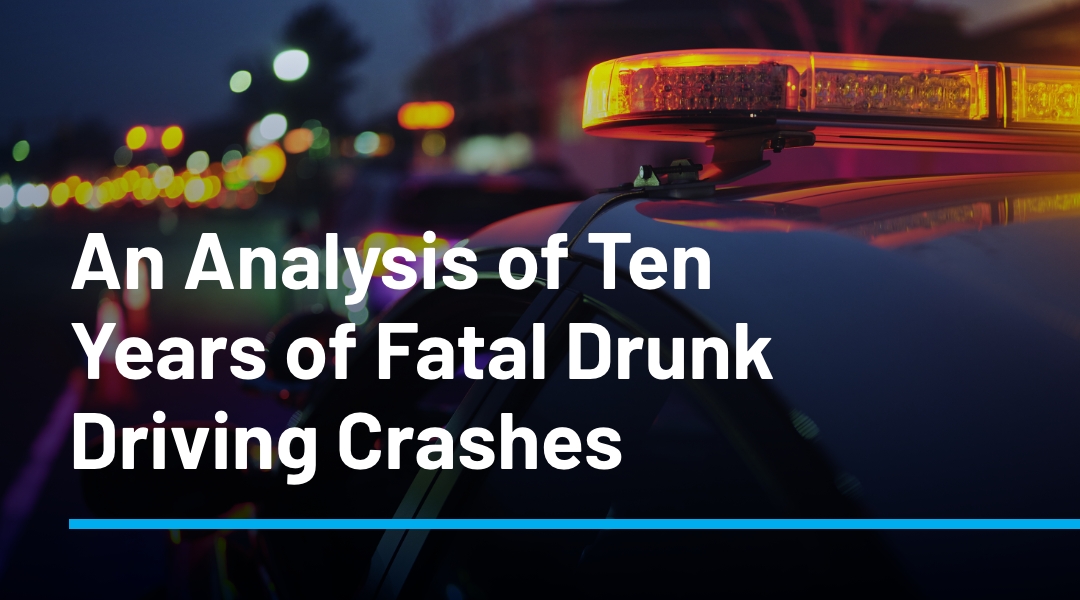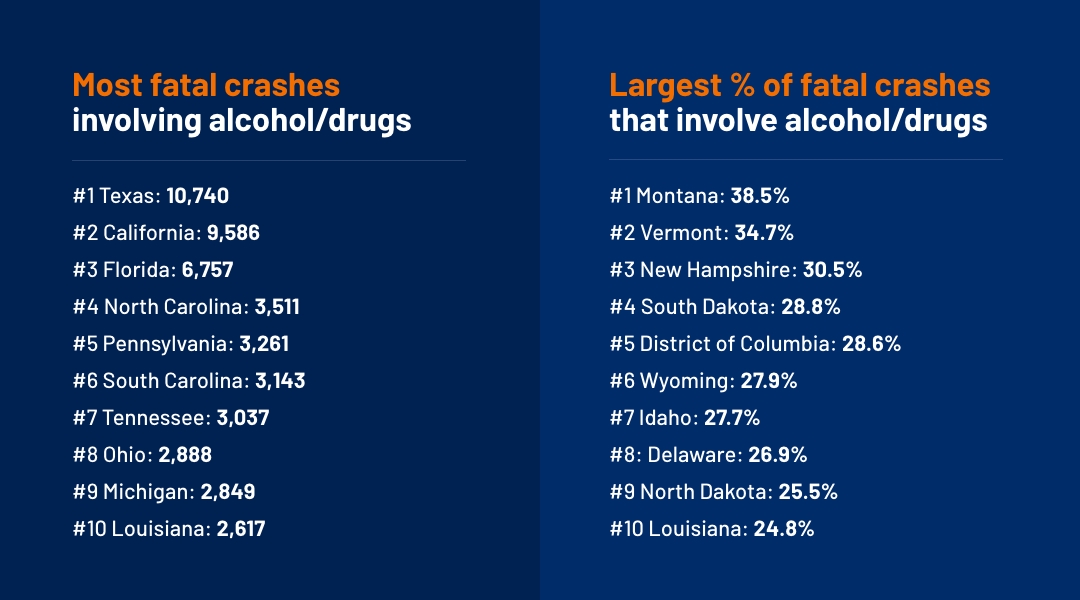
In 2021, 13,384 people died in alcohol-related car crashes in the United States — more than 30% of all traffic deaths, according to statistics from the National Highway Transit Safety Administration. That works out to a preventable death every 39 minutes, even before you account for any deaths caused by drivers under the influence of drugs rather than alcohol.
And it doesn’t take being over the legal limit (blood alcohol content of 0.08) for it to be dangerous to mix alcohol and automobiles. A BAC of 0.05 could reduce your coordination and make steering harder, and even a BAC as low as 0.02 is enough to make it harder to avoid distractions and pay attention to the road.
In order to look further at the dangers of impaired driving, we turned to the NHTSA’s Fatality Analysis Reporting System database, analyzing over 500,000 fatal motor vehicle crashes in the U.S. from 2012 through 2021 — roughly 89,000 of which involved at least one driver who was found to be under the influence of either alcohol or drugs.
KEY FINDINGS:
- Nearly 40% of fatal crashes that involve drugs or alcohol occur between 10 p.m. and 4 a.m., and nearly 40% of all fatal crashes between midnight and 4 a.m. involve alcohol or drugs.
- Male drivers involved in fatal car crashes are almost 50% more likely than their female counterparts to be under the influence, with the highest rates coming from men in their 20s.
- There are more fatal crashes involving alcohol or drugs in Texas than in any other state, but the state is only 19th in terms of the percentage of fatal crashes that involve alcohol or drugs.
- If the Dallas/Fort Worth Metroplex were a state, it would have the 16th-most fatal crashes involving alcohol or drugs.
Where are fatal crashes involving drugs and alcohol happening the most often?
Texas is first among all states in the number of fatal crashes involving drugs and alcohol, with more than 10,700 from 2012 to 2021. But that’s not necessarily a surprise considering that Texas also has the most overall fatal crashes in that time period, with 51,672.
If you look at the percentage of fatal crashes that involve alcohol or drugs, Texas ranks 19th, while areas with smaller populations like Montana, Vermont, and New Hampshire top the list. Louisiana is the only state to fall in the top 10 of both metrics.

The Dallas-Fort Worth metropolitan area has a rate of fatal crashes involving drugs and alcohol that is just slightly below the statewide average of 20.8%, but it is also home to two of the 15 localities with the largest numbers of fatal crashes involving impaired drivers: Dallas County is #5 on the list with 795 such crashes, while Tarrant County is #13 with 473.
Three other Texas counties were among the top 20 jurisdictions: Harris County (Houston), which had more such crashes than any other county in the U.S. (and nearly as many as the entire Metroplex combined); Bexar County (San Antonio); and Travis County (Austin).
If you grouped the 11 counties of the Metroplex together into one state, that state would have the 16th-most fatal crashes involving drugs and alcohol in the country.
When are fatal crashes involving impaired drivers happening?
It should come as no surprise that impaired-driving crashes are most common on the weekend. From 2012 through 2021, there were more fatal crashes involving alcohol and drugs on Saturday and Sunday (from drivers who most likely started their substance use on Friday and Saturday nights) than Monday through Thursday combined.
Late nights are the most frequent times for these deadly crashes too. Close to 40% of fatal crashes involving drugs and alcohol happen between 10 p.m. and 4 a.m., and more than 40% of all fatal crashes that occur from midnight to 4 a.m. on weekends involve impaired drivers (by comparison, less than 9% of fatal crashes during regular weekday business hours involve drugs or alcohol.
Who is getting in car accidents while under the influence?
Averaging across all age groups, male drivers in fatal crashes are roughly 50% more likely to be under the influence of alcohol or drugs than female drivers. In fact, when separating drivers out into buckets by age group, nearly every age group of male drivers had gotten into more accidents while impaired than the group of female drivers with the highest number of fatal crashes under the influence.
Younger drivers are at the highest risk as well. 1 in 4 male drivers under the age of 30 who is involved in a fatal crash is under the influence, according to NHTSA data, along with 1 in 6 female drivers under the age of 30. Both of those rates are at least twice as high as the percentage of drivers over 50 in fatal crashes who are impaired by drugs or alcohol.
So what should you do to avoid the risks of drunk driving?
The most important thing is to avoid drinking and driving. Call a taxi, a ride-sharing service, or a friend who has not been drinking to come pick you up. And don’t let friends who have been drinking or using drugs get behind the wheel — the risk is just too great.
And if you’re on the road late at night on a weekend, when impaired drivers are most likely to get in crashes, make sure you’re paying careful attention to your surroundings and wearing your seatbelt — which you should be doing anyway in order to comply with Texas state law and avoid a costly ticket!
Data sources and methodology
Crash data comes from the full public data releases for 2012 through 2021 from the Fatality Analysis Reporting System, a National Highway Transit Safety Administration database that catalogs information about fatal motor vehicle crashes in the 50 states, the District of Columbia, and Puerto Rico.
Other statistics on impaired driving also come from the NHTSA.
Feel free to use the information contained in this analysis, but if you do, please link back to this page for attribution purposes.